My sister was the one who loved horses in my family. A pair of disgruntled ponies instilled a wariness in me, but as an adult, I appreciate the beauty and power of horses. Jennifer Thermes’ new picture book HORSE POWER: HOW HORSES CHANGED THE WORLD caught my eye after I had spent time thoroughly enjoying her previous book, MANHATTAN: MAPPING THE STORY OF AN ISLAND. (I shared that book in a blog post a while back.) Here Jennifer shares her process of finding and maintaining focus, a huge challenge with a “big picture” topic.
Thank you to Jennifer for offering a GIVEAWAY! Just leave a comment after the post for a chance to win HORSE POWER.
Congratulations to last week’s winner of one of Ann Marie Stephens’ math books, Laura Perdew!
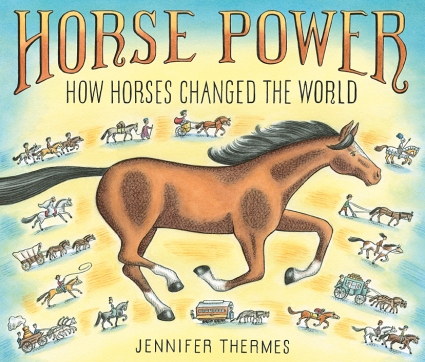 Finding the Focus in Big Picture History by Jennifer Thermes
Finding the Focus in Big Picture History by Jennifer Thermes
Horse Power: How Horses Changed the World, Abrams Books for Young Readers, 2021
From ancient images on cave walls, to paintings, sculptures, statues, and more, humans have always been enamored by the horse. As a young girl, so was I. Seeing the world from high on a horses’ back, becoming attuned to another living creature, and learning about the unique personalities of every different horse was magic to me… including their warm, earthy smell!
Today, horses are mostly seen as a luxury. But from the time they were first domesticated up until the early 20th century, horses were the engines that powered much of human history. Horses evolved in a way that made them easier for humans to domesticate. They were used in agriculture. They carried travelers and traders across the land, enabling people from different cultures to communicate and connect with each other. They inspired inventions, including the design of all kinds of wheeled vehicles—which in turn led to the need to build better roads. And they were used to wage war. (It’s helpful to remember that horses had no say about any of the ways in which they were used.)
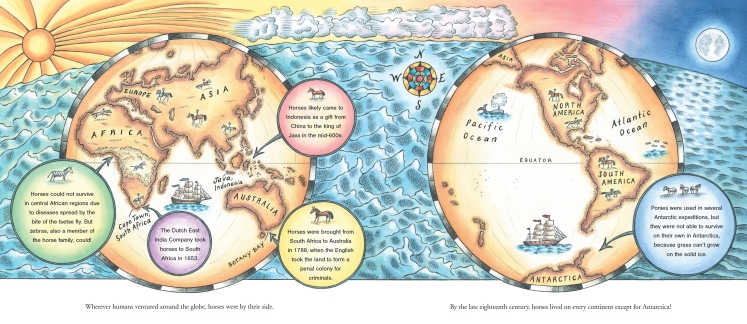
The idea of one element of history leading to another across long spans of time fascinates me. The challenge with big-picture history becomes how to narrow the focus of the story to fit into the limited number of pages in a picture book. In the case of Horse Power, I had 48 pages, plus endpapers to work with.
I’m a huge fan of using sticky notes to remind myself of the main points of the story. In the case of Horse Power they read:
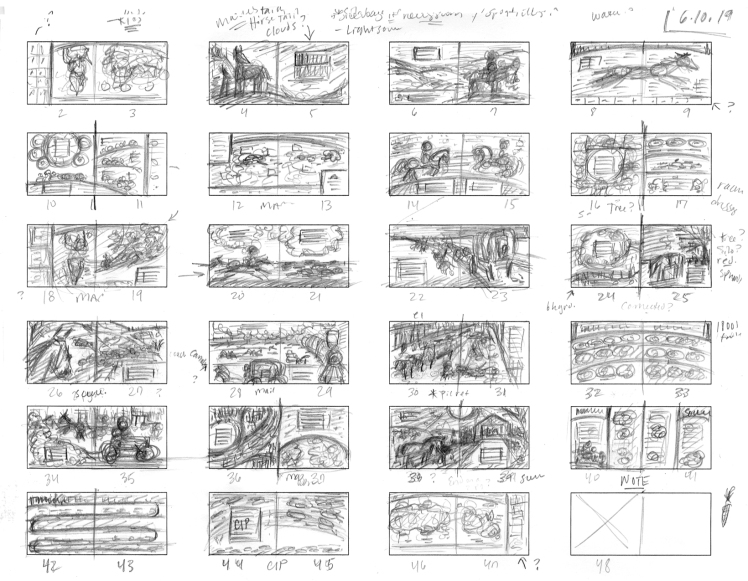
1) Talk about the horses (without anthropomorphizing them!)
2) History in which horses played a part.
3) How horses influenced humans and society.
These reminders may seem obvious, but after being immersed in countless interesting facts and events, while at the same time trying to figure out how to balance the information between words and visuals, it’s easy for your brain to gallop off in too many directions! Keeping these notes to myself on the wall where I can see them every day helps me stay focused on the main throughline of the story.
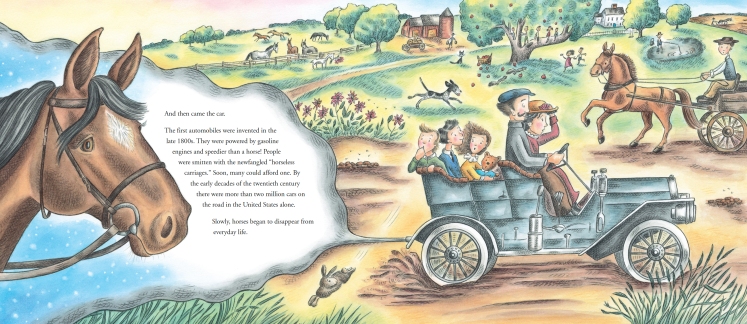
It’s also good to remember that a picture book can’t possibly contain every nugget you want to include. And often, limitations are good, because they force you to hone in on your story. The reader can use the book as a jumping off point to learn more about the subject.
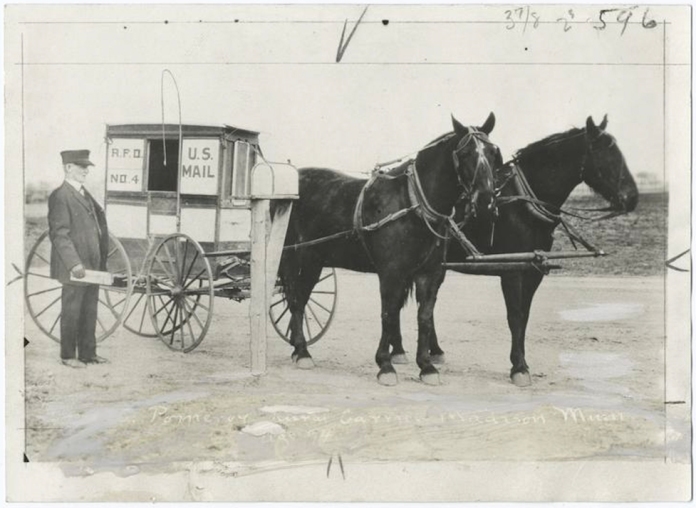
Finally, I like to envision the book as an overall design that makes it readable straight through as a story, or one that a reader can jump in and out of. By using sidebars, illustrations, and maps to convey tidbits that might not fit into the main narrative, I hope to make the book something that the reader wants to return to again and again– to learn something new each time!
Don’t forget to leave a comment for a chance to win HORSE POWER! (continental US addresses only, please)
BIO
Jennifer Thermes is an award-winning author, illustrator, and map illustrator. Manhattan: Mapping the Story of an Island(Abrams, 2019) was a 2020 NCTE Orbis Pictus Honor Book. She is fascinated by the connections between past and present history, and how the world today has come to be the way it is. To learn more, please visit https://jenniferthermes.com/.
Thank you for sharing info about your process, Jennifer. It’s hard to narrow the focus in nonfiction. You do it well. I love your books!
LikeLiked by 2 people
Oh, I’m so excited to read this and see how you narrowed focus. I love the points you made and suggestions to help us kid lit creators stay on task.
LikeLiked by 2 people
This book sounds great. Narrowing the scope for a picture book – bio or other NF in particular – is always such a challenge. Thank you for sharing your process.
LikeLiked by 2 people
“The idea of one element of history leading to another across long spans of time fascinates me.” I love books that show connections…with history, with science…you name it.
LikeLiked by 2 people
Interesting read! Thank you for sharing your process with us!
LikeLiked by 2 people
Your book is on a really interesting topic. As a writer, it’s nice to learn about how you approach fitting your research into a picture book format.
LikeLiked by 2 people
The first thing I thought of here was War Horse, the story about a horse during WWI. So true that much of our world was shaped by the “use” of horses before the internal combustion engine was invented. This sounds like an interesting read.
LikeLiked by 2 people
Sharing your process on narrowing down the focus is so helpful to me. Have sticky notes, will post!
LikeLiked by 2 people
Thank you all for the lovely comments! I’m so glad you found the post helpful. It’s amazing how often squirrel-brain takes over when making a book. I need constant reminders to focus! 🙂
LikeLiked by 1 person
I love that term – squirrel brain. I definitely have that going on, too!
LikeLike
Hi, there!
I found this fascinating because I bought Manhattan at Books of Wonder uptown (now closed) at your talk with others on NYC. I just listened to BOWERY BOYS history podcast about horses in NYC, so this is topic fresh in my mind. It’s interesting in so many ways. Your technique is a good way to hone in. Picking out rose main points to meld it all together into a flowing storyline. (CBIG)
LikeLiked by 2 people
Thank you, Marilyn! I remember that day at Books of Wonder. 🙂
LikeLiked by 1 person
Horses are still my favorite of all animals. I still wish I had the land to be able to own and care for one. I’m going to love reading your book.
LikeLiked by 2 people
This sounds like a wonderful book .I can’t wait to share this with the two wonderful horse women in my life.
Staying focused and on topic is one of the strategies I always attempted to get my students to use when they were writing non fiction.
LikeLiked by 2 people
Really enjoyed Jennifer’s journey and process. My daughter was quite a horsewoman when she was younger. She would have enjoyed learning more about this history of horses. Sounds like you had fun researching and choosing what to share.
LikeLiked by 2 people
OOO! I love and need to write a couple of reminders for me to keep focus, too. Great tip!
LikeLiked by 1 person
This is such a great post. Thanks!
LikeLiked by 2 people
What a wonderful topic for a Children’s book! I love nonfiction. Horses are fascinating animals, and growing up, I loved reading author Marguerite Henry’s stories about horses. Thank you for sharing your process, Jennifer.
LikeLiked by 2 people
Thanks!
Helpful, and interesting, and I’m definitely looking forward to checking out the book now!
LikeLiked by 2 people
Thank you for sharing your process. My girls are horse crazy and would love this book.
LikeLiked by 2 people
What an awesome book! I love horses and I can just imagine the rabbit hole the awaited your decision to tackle this project. Great cover and look forward to seeing the rest of it. Congratulations.
LikeLiked by 2 people
Oftentimes, it seems the topics I want to write about contain so many nuggets the writing task becomes overwhelming. Using sticky notes on the wall to map out the story and stay the course is a great idea.
LikeLiked by 2 people